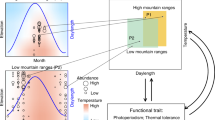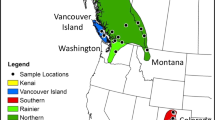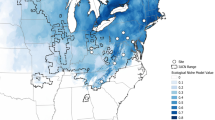Abstract
Under changing climatic conditions, species need to adapt to their new environment. Genetic adaptation is crucial to prevent population extinction1 but examples where climate change leads to genetic changes in wild populations have been few2,3. The synchronization between the timing of egg hatching of a herbivorous insect, the winter moth (Operophtera brumata), and the seasonal bud burst of its food plant, oak (Quercus robur), has been disrupted by climate change4 and a quantitative genetic model predicts that selection will delay the egg hatching date5. Here we show, using both long-term observational data and experiments, that the egg hatching date has changed genetically, resulting in closer synchrony with oak bud burst. The observed rate of change matches the predicted rate of change of one day per year. Hence, altered selection pressures, caused by environmental change, result in a rapid adaptive response in insect phenology. These genetic changes in a key life-history trait in this herbivorous insect therefore seem to be fast enough to match the climate-change-induced advancement of their host phenology.
This is a preview of subscription content, access via your institution
Access options
Subscribe to this journal
Receive 12 print issues and online access
$209.00 per year
only $17.42 per issue
Buy this article
- Purchase on Springer Link
- Instant access to full article PDF
Prices may be subject to local taxes which are calculated during checkout


Similar content being viewed by others
References
Visser, M. E. Keeping up with a warming world; assessing the rate of adaptation to climate change. Proc. R. Soc. Lond. B 275, 649–659 (2008).
Gienapp, P., Teplitsky, C., Alho, J. S., Mills, J. A. & Merila, J. Climate change and evolution: Disentangling environmental and genetic responses. Mol. Ecol. 17, 167–178 (2008).
Merila, J. Evolution in response to climate change: In pursuit of the missing evidence. Bioessays 34, 811–818 (2012).
Visser, M. E. & Holleman, L. J. M. Warmer springs disrupt the synchrony of oak and winter moth phenology. Proc. R. Soc. Lond. B 268, 289–294 (2001).
Van Asch, M., van Tienderen, P. H., Holleman, L. J. M. & Visser, M. E. Predicting shifts in phenology in response to climate change, an insect herbivore example. Glob. Change Biol. 13, 1596–1604 (2007).
Bale, J. S. et al. Herbivory in global climate change research: Direct effects of rising temperature on insect herbivores. Glob. Change Biol. 8, 1–16 (2002).
Bradshaw, W. E. & Holzapfel, C. M. Climate change—evolutionary response to rapid climate change. Science 312, 1477–1478 (2006).
Parmesan, C. & Yohe, G. A globally coherent fingerprint of climate change impacts across natural systems. Nature 421, 37–42 (2003).
Both, C., Bouwhuis, S., Lessells, C. M. & Visser, M. E. Climate change and population declines in a long-distance migratory bird. Nature 441, 81–83 (2006).
Pigliucci, M. Phenotypic Plasticity; Beyond Nature and Nurture (John Hopkins Univ. Press, 2001).
Kramer, K. Phenotypic plasticity of the phenology of seven European tree species in relation to climatic warming. Plant Cell Environ. 18, 93–104 (1995).
Menzel, A. Trends in phenological phases in Europe between 1951 and 1996. Int. J. Biometeorol. 44, 76–81 (2000).
Root, T. L. et al. Fingerprints of global warming on wild animals and plants. Nature 421, 57–60 (2003).
Roy, D. B. & Sparks, T. H. Phenology of British butterflies and climate change. Glob. Change Biol. 6, 407–416 (2000).
Kearney, M. R. et al. Early emergence in a butterfly causally linked to anthropogenic warming. Biol. Lett. 6, 674–677 (2010).
Nussey, D. H., Postma, E., Gienapp, P. & Visser, M. E. Selection on heritable phenotypic plasticity in a wild bird population. Science 310, 304–306 (2005).
Visser, M. E. & Both, C. Shifts in phenology due to global climate change: The need for a yardstick. Proc. R. Soc. Lond. B 272, 2561–2569 (2005).
Thackeray, S. J. et al. Trophic level asynchrony in rates of phenological change for marine, freshwater and terrestrial environments. Glob. Change Biol. 16, 3304–3313 (2010).
Donnelly, A., Caffarra, A. & O’Neill, B. F. A review of climate-driven mismatches between interdependent phenophases in terrestrial and aquatic ecosystems. Int. J. Biometeorol. 55, 805–817 (2011).
Van Asch, M. & Visser, M. E. Phenology of forest caterpillars and their host trees: The importance of synchrony. Annu. Rev. Entomol. 52, 37–55 (2007).
Feeny, P. Seasonal changes in oak leaf tannins and nutrients as a cause of spring feeding by winter moth caterpillars. Ecology 51, 565–581 (1970).
Tikkanen, O. P. & Julkunen-Tiitto, R. Phenological variation as protection against defoliating insects: The case of Quercus robur and Operophtera brumata. Oecologia 136, 244–251 (2003).
Buse, A. & Good, J. E. G. Synchronization of larval emergence in winter moth (Operophtera brumata L.) and budburst in pedunculate oak (Quercus robur L.) under simulated climate change. Ecol. Entomol. 21, 335–343 (1996).
Singer, M. C. & Parmesan, C. Phenological asynchrony between herbivorous insects and their hosts: Signal of climate change or pre-existing adaptive strategy? Phil. Trans. B 365, 3161–3176 (2010).
Kinnison, M. & Hendry, A. P. The pace of modern life II: From rates of contemporary microevolution to pattern and process. Genetica 112–113, 145–164 (2001).
Van Asch, M., Julkunen-Tiito, R. & Visser, M. E. Maternal effects in an insect herbivore as a mechanism to adapt to host plant phenology. Funct. Ecol. 24, 1103–1109 (2010).
Bradshaw, W. E. & Holzapfel, C. M. Genetic shift in photoperiodic response correlated with global warming. Proc. Natl Acad. Sci. USA 98, 14509–14511 (2001).
IPCC Climate Change 2007: The Physical Science Basis (eds Solomon, S. et al.) (Cambridge Univ. Press, 2007).
Falconer, D. S. & Mackay, T. F. C. Introduction to Quantitative Genetics (Longman, 1996).
Van Tienderen, P. H. & Koelewijn, H. P. Selection on reaction norms, genetic correlations and constraints. Genet. Res. 64, 115–125 (1994).
Acknowledgements
Family Van Boetzelaer Van Oosterhout, Stichting Het Gelders Landschap, Stichting Nationaal Park De Hoge Veluwe and Natuurmonumenten kindly gave permission to work in their woodlands. T. Reed provided valuable comments on an earlier version of the manuscript. A NWO-Life Sciences Foundation (ALW grant 812.04.009) supported this research. M.E.V. is supported by a NWO-VICI grant.
Author information
Authors and Affiliations
Contributions
M.E.V. and L.J.M.H. set up the long-term field data collection, M.v.A. and M.E.V. designed the experiment, M.v.A., L.S., L.J.M.H., B.v.L. and M.E.V. collected the long-term field data, M.v.A., L.J.M.H. and B.v.L. carried out the experiment, M.v.A. and M.E.V. analysed the data and M.v.A., L.S. and M.E.V. wrote the paper.
Corresponding author
Ethics declarations
Competing interests
The authors declare no competing financial interests.
Supplementary information
Supplementary Information
Supplementary Information (PDF 252 kb)
Rights and permissions
About this article
Cite this article
van Asch, M., Salis, L., Holleman, L. et al. Evolutionary response of the egg hatching date of a herbivorous insect under climate change. Nature Clim Change 3, 244–248 (2013). https://doi.org/10.1038/nclimate1717
Received:
Accepted:
Published:
Issue Date:
DOI: https://doi.org/10.1038/nclimate1717
This article is cited by
-
A life-history allele of large effect shortens developmental time in a wild insect population
Nature Ecology & Evolution (2023)
-
Relationships of temperature and biodiversity with stability of natural aquatic food webs
Nature Communications (2023)
-
Variation in breeding phenology in response to climate change in two passerine species
Oecologia (2023)
-
Large-scale genome-wide study reveals climate adaptive variability in a cosmopolitan pest
Nature Communications (2021)
-
Biodiversity conservation in climate change driven transient communities
Biodiversity and Conservation (2021)



